- The 2020 Ford Explorer arrives as Americans demand more and more SUVS.
- Ford analyzed consumer feedback and designed the 2020 Explorer accordingly.
- New, more powerful engines compliment a host of convenience and safety tech.
In March of 1990, minivans broke into a cold sweat when the 1991 Ford Explorer moved into the neighborhood. While the two-door Explorer “Sport” helped the single crowd pursue all things 90s, the four-door became a viable option for families. Contrasting the minivan, the Explorer still had cargo space (81 cubic feet in 1991), kid-friendly features (child-proof rear door locks by 1992), and a ruggedness reserved for trucks (an advanced 4×4 system arrived in 1995).
A luxurious Eddie Bauer option meant these “truck-like” rides were even comfortable.
By Popular Demand
Today, Americans seek trucks and SUVs more than any other type of vehicle. According to the Associated Press, new vehicle sales in the United States rose 0.3 percent over a year ago to 17.27 million vehicles. By comparison, cars made up 32 percent of the pie, while trucks and SUVs accounted for 68 percent. Traditional cars are fading from view, evidenced by recent model cancellations and the race to win younger generations over with SUVs and crossovers.
The 2020 Ford Explorer will likely ride this rising wave of consumer demand all the way to the bank. Yet keeping the Explorer relevant, now 30 years on, has its challenges. Luckily for Ford, we consumers are somewhat predictable. We want our cake. We want to eat it too. And Facebook.
“Explorer drivers told us what they want – more capability, more power, more space,” explained Hau Thai-Tang, Ford’s Head of Product Development and Purchasing. “They want more technology, not just for the driver, but for the whole family. And they want all of it with a beautifully sporty exterior.”
“We obsessed about what Explorer customers need and want,” added Bill Gubing, Explorer Chief Engineer. “We met with customer groups, pored through internet forums, and dissected social media posts to determine what they love about today’s Explorer and understand their pain points. Then we found ways to improve it across the board.”
Here is an in-depth look at those “improvements” in the 2020 Ford Explorer.
Power & Performance: Turbo City
The Ford Explorer’s first 4.0-liter V6 delivered 155 horsepower and 220 lb-ft. of torque. An all-aluminum, single-overhead cam 4.6-liter V8 appeared in 2006 along with a six-speed automatic.
And my how things have changed.
The 2020 Ford Explorer leverages two of the automaker’s multi-platform EcoBoost engines for V8-like power. The EcoBoost is famous for turbo charging in lieu of larger displacement, becoming an overnight sensation after teaming with the 2011 F-150. In reality, the EcoBoost existed well before the 2011 F-150 but that’s a story for another time.
Concerning the new Explorer, the top EcoBoost, a V6 plant, is projected for 365 horsepower and 380 lb.-ft. of torque on 93 octane. The 2.3-liter EcoBoost, an in-line four by contrast, is projected for 300 horsepower and 310 lb-ft. of torque. Here’s something to chew on: The 1996 Ford Explorer had 215 horsepower and 280 lb-ft. of torque. With a 5.0 V8.
When properly equipped, the 3.0-liter EcoBoost tows up to 5,600 lbs., a 12 percent increase over the 3.5-liter EcoBoost it replaces. The 2.3-liter gets a solid bump in towing capacity too, now tugging 5,300 lbs. with a Class III Trailer Tow Package versus its current 3,000 lbs. rating.
Lucky #7: Drive Modes
With the available Terrain Management System, the 2020 Ford Explorer offers seven different drive modes, although there is a caveat. The new Explorer is predicated upon a rear-wheel drive architecture, which according to Ford, enables a sportier, more athletic design, improved driving capabilities etc. etc.
And fair enough.
That said, real-wheel drive Explorers receive only six drives modes, excluding Deep Snow/Sand. Here is what they look like:
#1. Normal
Exactly what it sounds like. Use for everyday driving.
#2. Sport
Increases throttle and steering responses while the suspension stiffens. The transmission holds gears longer to increase acceleration.
#3. Eco
If Sport Mode were Red Bull, this is carbonated water.
#4. Tow/Haul
This mode makes the transmission more efficient when towing. Tow/Haul is especially handy when climbing hills as it keeps the transmission out of overdrive. When cresting a hill, pressing the brake pedal in this mode facilates engine braking.
#5. Slippery
When Wet. Bon Jovi anyone? Slippery mode adjusts pedal response, traction control, and the transmission when ice or gravel is present. Ford says this mode even works on grass. So now you can park on your front lawn. Also, side note, the Explorer offers a 980-watt, 14-speaker B&O premium audio system. What’s your favorite Bon Jovi album now?
#6. Deep Snow/Sand
Similar to Slippery, this mode adjusts the pedal response, traction control, and the transmission for heavier snow and sand.
#7. Trail
When canvassing those muddy, uneven back roads, use this mode.
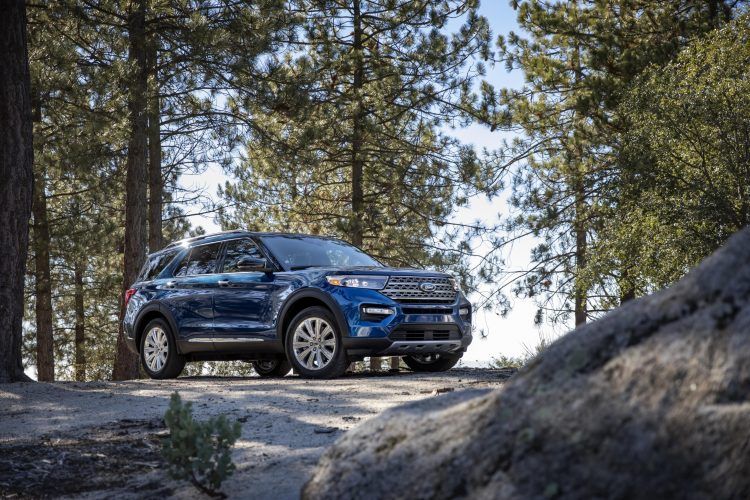
With the available Terrain Management System, the 2020 Ford Explorer offers seven different drive modes. Photo: Ford Motor Company.
Captain & Co-Pilot: Safety & Security
2002 was a milestone year for the Explorer in terms of safety. Ford’s AdvanceTrac stability control was introduced, along with four-wheel antilock braking and electronic brake force distribution. Ford’s Personal Safety System featured dual-stage driver and front-passenger airbags, their deployment based on crash severity, driver’s seat position, and front occupant safety-belt usage.
Fast forward 18 years to Co-Pilot360, a suite of advanced driver assistance systems, standard on the 2020 Ford Explorer. Co-Pilot 360 includes Pre-Collision Assist with Automatic Emergency Braking, Pedestrian Detection, Forward Collision Warning, and Evasive Steering Assist – all to help avoid a collision. Post impact, Co-Pilot 360 deploys the brakes to lessen the impact of a secondary collision.
Blind Spot Information with Cross-Traffic Alert, Adaptive Cruise Control with Speed Sign Recognition, and a review camera are also part of Co-Pilot 360.
“It’s not about filling the vehicle with technology for technology’s sake,” said Chris Billman, Ford Co-Pilot360 Engineering Manager. “It’s about improving the experience, making driving less stressful, and helping the driver to feel more confident behind the wheel.”
Those who live in bustling neighborhoods may consider adding the available Reverse Brake Assist. The feature uses radar and ultrasonic sensors to detect objects while backing up, applying the brakes automatically if something gets too close. Useful especially for exiting the driveway. Reverse Brake Assist is an enhanced version of the original Reverse Sensing, which first appeared on the Explorer in 1999.
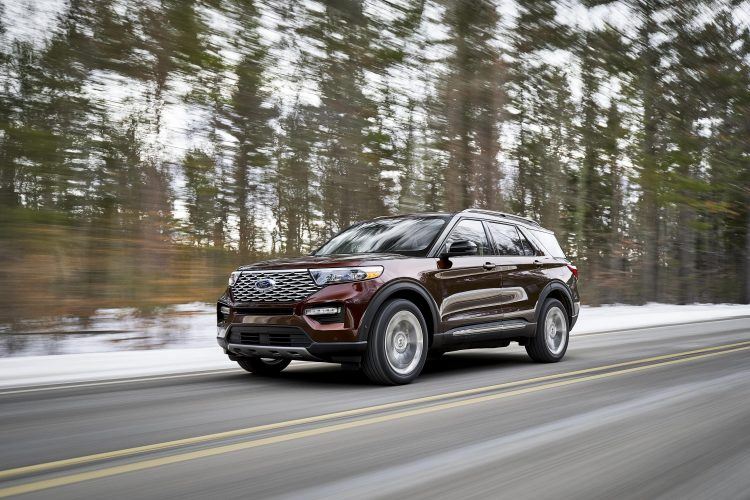
The Lane-Keeping System, part of Co-Pilot 360, helps the 2020 Ford Explorer remain steady on the open road. Photo: Ford Motor Company.
Beam Me Up: Technology & Connectivity
Everything but the kitchen sink! (and that might even be in there somewhere with the new Explorer’s 87.8 cubic feet of cargo space). Passengers in all three rows can settle in with FordPass Connect, a standard feature that serves up 4G LTE Wi-Fi for up to 10 mobile devices. For drivers, FordPass Connect gives them remote access to their Explorer via their phone.
They can lock, unlock, locate and start the SUV, and monitor vehicle diagnostics from the app.
A tablet-like touchscreen display resides on the center stack, employing capacitive glass to mimic the feel of our modern smartphones. The standard SYNC 3 infotainment system includes Apple CarPlay, Android Auto, and Waze navigation.
Keeping the juice flowing should be easy in the 2020 Ford Explorer. There’s an available wireless charging pad, up to four USB ports, including new type-C outlets, up to three 12-volt outlets, and a 110-volt outlet. And to think, back in 2007, an auxiliary input for the stereo became standard equipment for the Explorer. That was a big deal back then.
Putting It All Together
The 2020 Ford Explorer comes in base, XLT, Limited, Limited Hybrid, ST, and Platinum flavors. The 2.3-liter EcoBoost is standard on base, XLT, and Limited, with the Platinum getting the larger V6. Both are paired to a new 10-speed automatic. 18-inch wheels are standard although Platinum models come with 21-inchers. In total, there are seven wheel designs on offer.
Naturally, the Platinum gets all the fixin’s: door handles with satin aluminum inserts, liftgate appliqué, roof-rack side rails, moonroof, leather seats, and a leather-wrapped steering wheel.
Expect the 2020 Ford Explorer this summer. The Chicago Assembly Plant has production honors.
Carl Anthony studies mechanical engineering at Wayne State University, serves on the Board of Directors for the Ally Jolie Baldwin Foundation, and is a loyal Detroit Lions fan. Before returning to school, he simultaneously held product development and experiential marketing roles in the automotive industry.
2020 Ford Explorer Gallery















Photos & Source: Ford Motor Company.
https://www.automoblog.net/2019/01/11/2020-ford-explorer/
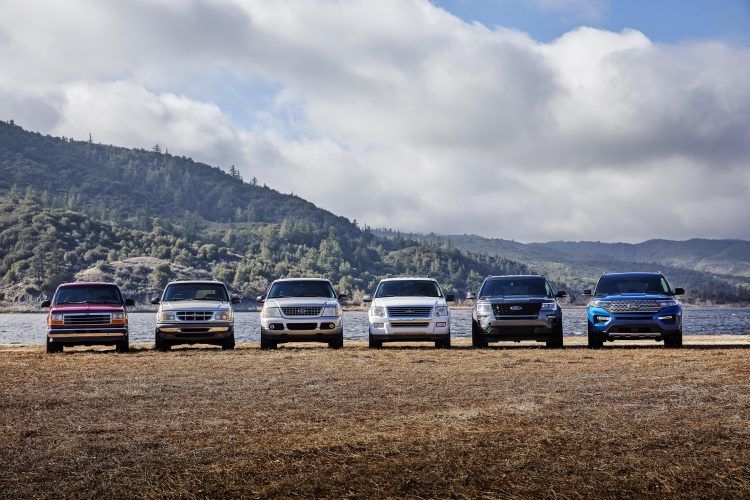
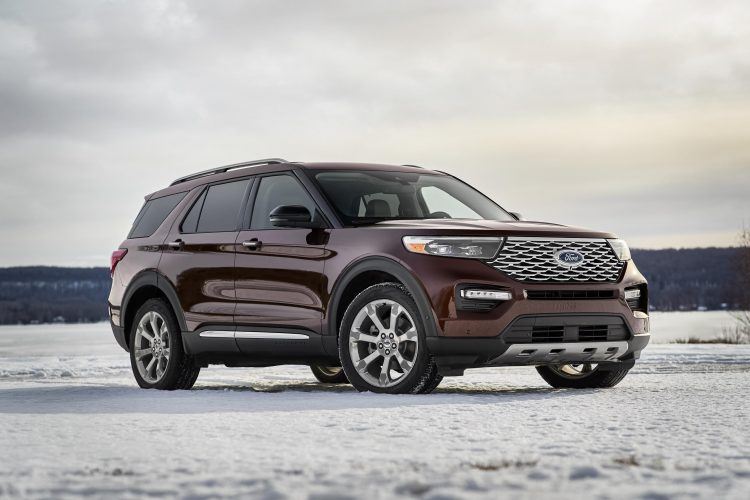
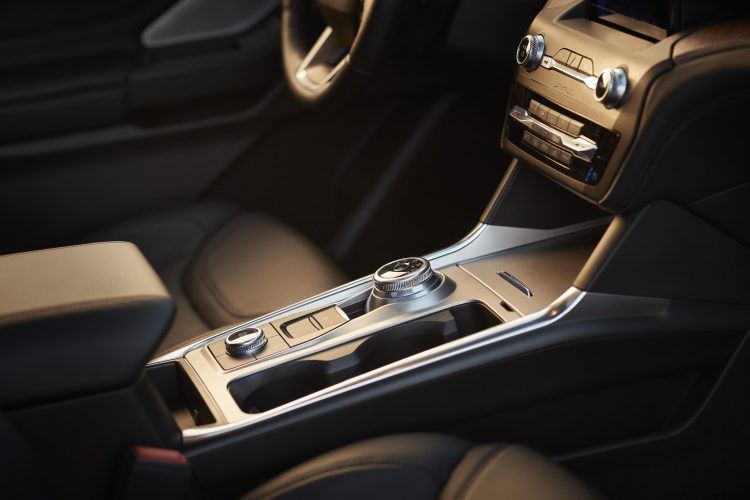
No comments:
Post a Comment